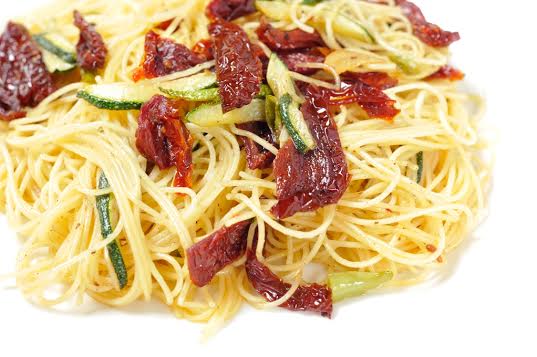
Just an hour after he started, chef Luciano Paolo Nesi was done with his cooking demonstration at the Maya Kitchen Culinary Center. And to think he prepared five dishes in all: Crystal Bay oysters cooked two ways (with lemon air and with spinach and cheese sauce); capellini pomodoro secchi (angel hair pasta with sundried tomatoes); scamorza alla griglia (grilled smoked mozzarella with fresh pork sausage topped with balsamic cream); funghi trifolati (assorted mushrooms in garlic and extra-virgin olive oil) and panna cotta con miele (panna cotta with honey syrup).
But that’s probably the Italian way. At L’Opera restaurant, where he’s executive chef, Nesi said they cook everything very fast. Not that there’s any shortcut involved. In fact, they make their own pasta from scratch (except for the spaghetti), using durum wheat semolina flour brought in from Italy.
“We use semolina because it’s a hard type of flour. Because it’s strong, it can stay al dente,” said Nesi.
What lets them cook the dishes fast is the freshness and the advance preparation of the ingredients. Everything must be sliced, chopped and peeled before the actual cooking begins.
A native of Tuscany, Nesi is a certified sommelier who has opened 27 restaurants worldwide in a career that now spans 40 years. In 1994, he came to the Philippines and, with some Filipino partners, established L’Opera to provide the local scene with “an uncompromising authentic Italian dining experience.”
Indeed, L’Opera has been certified by Eccellenze Italiane as one of the Italian excellencies in the Expo Milano 2014-15. It was also nominated by Manila’s Best Kept Restaurant Secrets as one of Manila’s best Italian restaurants in 2014.
Here’s one of the recipes Nesi prepared at the Maya Kitchen last Saturday: angel hair pasta with sundried tomatoes in spicy extra-virgin olive oil.
Capellini Pomodoro Secchi
12-16 c water, for boiling the pasta
Salt
200 g capellini pasta (angel hair pasta)
¼ c extra-virgin olive oil
1 small zucchini (100 grams), sliced thinly into half-moon sizes
½ head garlic, sliced
2 tbsp finger chilies, sliced
½ c sun-dried tomatoes, soaked in warm water for about 10 minutes
Salt and pepper, to taste
In a large pot, bring the water to a rolling boil. Add the salt. Let the water boil for one to two more minutes then add the pasta. After one minute, stir the pasta to keep it from sticking. Let the pasta cook until just before it reaches the al dente stage.
Meanwhile, in a large pan, heat the olive oil. Sauté the zucchini until slightly tender, then add the garlic and chilies. Drain the tomatoes and cut them into bite-size pieces. Add the tomatoes to the pan and simmer for a few minutes. Season with salt and pepper to taste. Turn off the heat but keep the sauce warm. The sauce must be ready by the time the pasta is cooked.
Set aside about one to two cups of the water used for boiling the pasta. Drain the pasta then transfer it to the prepared sauce. Simmer, stirring gently, until the pasta is cooked to al dente stage. If the pasta looks dry, add some of the reserved pasta water.
Serve immediately.
L’Opera Ristorante Italiano is at The Fort Entertainment Complex 26th cor. 7th Ave., Bonifacio Global City, Taguig. Call 8893963. The group also operates Balducci Restaurant in Serendra and Trattoria in Shangri-la Plaza Mall.
For more courses in The Maya Kitchen, visit www.themayakitchen.com; or e-mail contactus@themayakitchen.com
Chef Paolo Nesi’s tips for cooking pasta
Start with plenty of water. When cooking pasta, the more water you use, the better.
After the water has boiled, add the salt. But since the salt lowers the temperature of the water, wait about one to two minutes before putting in the pasta.
One minute after adding the pasta to the water, stir it so that the noodles don’t clump together.
Cook the pasta al dente or just before the al dente stage; it must still be firm and have some bite.
You must have the sauce ready by the time the pasta is cooked. Then add the pasta to the sauce and finish cooking the pasta with the sauce. This lets the pasta absorb the flavors of the sauce.
If the pasta looks a bit dry, add some of the water used for cooking the pasta (hence reserve one or two cups of pasta water before draining the pasta). The pasta water contains some of the gluten from the pasta, which will help make the sauce stick to the pasta.
For more tips, recipes and stories, visit author’s blog www.normachikiamco.com and Facebook fan page www.facebook.com/normachikiamco. Follow on Twitter @NormaChikiamco

